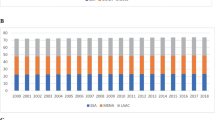Abstract
We analyse whether tourism (measured by real tourism receipts) causes growth in an asymmetric fashion in a panel of G-7 countries over the period of 1995–2014. Our results reveal that the tourism-led growth hypothesis holds for France, Germany, and the US, with negative tourism shocks being more important for Germany, Italy, Japan, while positive shocks are more important in UK and the US. Our results imply that, policy makers in Germany, Italy and Japan should be more concerned when tourism receipts decline.

Similar content being viewed by others

Notes
Balaguer and Cantavella-Jorda (2002), Gunduz and Hatemi-J (2005) and Oh (2005) were among the original studies to investigate the relationship between tourism and economic growth. For detailed literature review on this hypothesis, the reader is referred to (Arslanturk et al. 2011; Balcilar et al. 2014; Antonakakis et al. 2015a, b). For a recent literature review on the tourism-led growth hypothesis see Brida et al. (2016).
The figure is calculated using data from the annual report of UNWTO in 2015. World tourism receipts in 2014 were US$1245 billion and tourism receipts in the advanced economies for that year was US$815 billion.
The data can be accessed online from: http://databank.worldbank.org/data/reports.aspx?source=world-development-indicators.
Complete details of these summary statistics are available upon request from the authors.
References
Antonakakis N, Dragouni M, Filis G (2015a) Time-varying interdependencies of tourism and economic growth: evidence from European countries. Econ Model 44(C):142–155
Antonakakis N, Dragouni M, Filis G (2015b) Tourism and growth: the times they are a-changing. Ann Tour Res 50(C):165–169
Arslanturk Y, Balcilar M, Ozdemir ZA (2011) Time-varying linkages between tourism receipts and economic growth in a small open economy. Econ Model 28(1):664–671
Balaguer J, Cantavella-Jorda M (2002) Tourism as a long-run economic growth factor: the Spanish case. Appl Econ 34:877–884
Balcilar M, van Eyden R, Inglesi-Lotz R, Gupta R (2014) Time-varying linkages between tourism receipts and economic growth in South Africa. Appl Econ 46(36):4381–4389
Breusch TS, Pagan AR (1980) The Lagrange multiplier test and its applications to model specification in econometrics. Rev Econ Stud 47(1):239–253
Brida JG, Cortes-Jimenez I, Pulina M (2016) Has the tourism-led growth hypothesis been validated? Lit Rev 19(5):394–430
Granger CWJ (1969) Investigating causal relations by econometric models and cross-spectral methods. Econometrica 37:424–439
Gunduz L, Hatemi-J A (2005) Is the tourism-led growth hypothesis valid for Turkey? Appl Econ Lett 12:499–504
Hatemi-J A (2003) A new method to choose optimal lag order in stable and unstable VAR models. Appl Econ Lett 10:135–137
Hatemi-J A (2008) Forecasting properties of a new method to choose optimal lag order in stable and unstable VAR models. Appl Econ Lett 15(4):239–243
Hatemi-J A (2011) Asymmetric panel causality tests with an application to the impact of fiscal policy on economic performance in Scandinavia. MPRA paper no 55527
Hatemi-J A, Ajmi AN, El Montasser G, Inglesi-Lotz R, Gupta R (2016) Research output and economic growth in G7 countries: new evidence from asymmetric panel causality testing. Appl Econ 48(24):2301–2308
Im KS, Pesaran MS, Shin Y (2003) Testing for unit roots in heterogeneous panels. J Econom 115(1):53–74
Kónya L (2006) Exports and growth: granger causality analysis on OECD countries with a panel data approach. Econ Model 23:978–992
Oh C (2005) The contribution of tourism development to economic growth in the Korean economy. Tour Manag 26(1):39–44
Pesaran MH (2004) General diagnostic tests for cross section dependence in panels. CESifo Working Papers No.1233, pp 255–60
Pesaran MH, Yamagata T (2008) Testing slope homogeneity in large panels. J Econom 142:50–93
Swamy PAVB (1970) Efficient inference in a random coefficient regression model. Econometrica 38:311–323
Unite Nations World Tourism Organisation (2015) UNWTO annual report
World Travel and Tourism Council (2015) Travel and tourism economic impact
Acknowledgments
We would like to thank two anonymous referees for many helpful comments. This research was partially funded by the UAE University via the UPAR Program.
Author information
Authors and Affiliations
Corresponding author
Rights and permissions
About this article
Cite this article
Hatemi-J, A., Gupta, R., Kasongo, A. et al. Does tourism cause growth asymmetrically in a panel of G-7 countries? A short note. Empirica 45, 49–57 (2018). https://doi.org/10.1007/s10663-016-9345-3
Published:
Issue Date:
DOI: https://doi.org/10.1007/s10663-016-9345-3



